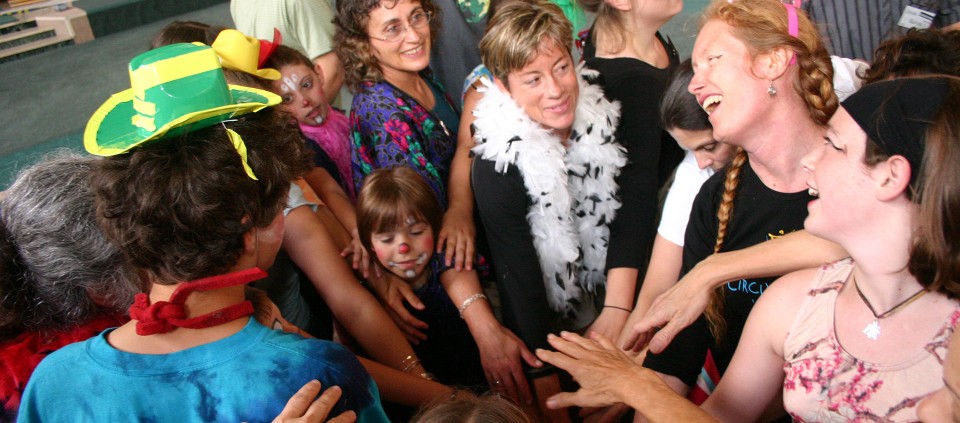The Human Art of Play: Where Circus and Yoga Meet

by Reyna Eisenstark
About a year ago, my kids and I, plus my boyfriend, his sister, and her husband—that is, four adults and two teenagers—went to an arcade together to play laser tag. The experience was kind of a revelation. As the six of us raced through the darkened rooms, jumping out and firing our lasers at each other, with the intensity and hilarity that the game requires, I had a feeling of utter giddiness that I had not known in a very long time. I could see that my children noticed this about me, too. What I mean is, my kids and I play games together and, as much fun as we have, I think that, to them, I am always their mother, playing a game with them. But this was different: I was running around and laughing like an actual child, and my own children were loving it.
What would life be like for parents and kids if we all did this more often? This is the question that Erin Maile O’Keefe and Kevin O’Keefe explore in every CircusYoga program they teach. In fact, they refer to CircusYoga, which combines interactive yoga and circus arts, as the “human art of play.” Their programs nearly always include parents and children, and both groups are expected to participate equally. As Erin points out, when parents and children take part in activities together, such as skiing, they often get separated in terms of ability. So the parents and kids are “side by side but not necessarily engaged,” she says. Or, as Kevin puts it, “Parents will say, ‘I went to the puppet show and my kid had a good time!’ We are adamant that parents have a full and complete experience, too. We want them to feel like they went on vacation.”
During CircusYoga workshops, Erin explains, kids are delighted to see their parents acting like children, and adults get an opportunity to play and be spontaneous. “We want kids to see their parents playing and taking risks,” says Kevin. “We want parents to see their kids fully engaged, and to think, ‘So this is what my kid is like when we’re not around!’”
Where do yoga and circus arts meet? Both have a strong physical element, which, says Erin, “provides a vast vocabulary of movement in the body.” But, at the same time, it is possible to take more from each practice, in both their approaches and their philosophies.
As Erin points out, the circus is wildly inclusive, whereas yoga is more of an internal practice, with a focus on self-awareness. When you combine them, they can balance each other. As Kevin notes, the interiority of yoga brings an awareness that isn’t usually found in circus arts. And the circus can bring celebratory principles to yoga.
CircusYoga is based on four principles: inclusion, connection, empathy, and co-authorship. And none of the activities are about getting it right. Erin explains, “We give a lot of space for everyone to express themselves. If someone is doing something different, I will point it out and say, ‘Let’s do it like that!’” In addition, nearly every activity is done in a circle, which Kevin calls “the shape of democracy.” As Erin puts it, “We’re constantly taking down hierarchies that might flare up, and you really get to see other.” The definition of CircusYoga can change with each iteration of the program, Kevin says. “We’re making up the practice with every new group of people. We’re giving them permission to inspire the workshop.”
What do parents and kids get out of sharing this experience together? Of course, at first, it just sounds like pure fun, and it is. “But then,” according to Erin, “they realize the profound lessons that come through this practice.” Once they’re back at home, parents often report that they’ve started to integrate play into their family culture—even turning doing the dishes into a game. One CircusYoga activity is called “the yes game,” in which you just say “yes” to whatever your partner offers you. Parents incorporate this into their real lives at home: “Let’s clean up the living room!” “Yes!” Erin explains, “There are profound ways to parent that are fun and creative—and that allows for a deeper connection.”
Reyna Eisenstark is a freelance writer living in Chatham, New York. You can read her blog, inspired by stories from her life, at reynaeisenstark.wordpress.com.
